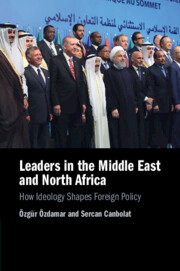Book contents
- Leaders in the Middle East and North Africa
- Leaders in the Middle East and North Africa
- Copyright page
- Contents
- Figures
- Tables
- Abbreviations
- 1 Political Ideology and Foreign Policy Decision-Making in the Middle East and North Africa
- 2 Political Islam and Sunni Ideology
- 3 Political Islam and Shia Ideology
- 4 Secularist Leaders in the Levant
- 5 Armed Nonstate Actors’ Foreign Policy
- 6 Leaders, Foreign Policy Decision-Making, and International Relations
- 7 Policy Implications and Future Research
- Bibliography
- Index
7 - Policy Implications and Future Research
Published online by Cambridge University Press: 03 August 2023
- Leaders in the Middle East and North Africa
- Leaders in the Middle East and North Africa
- Copyright page
- Contents
- Figures
- Tables
- Abbreviations
- 1 Political Ideology and Foreign Policy Decision-Making in the Middle East and North Africa
- 2 Political Islam and Sunni Ideology
- 3 Political Islam and Shia Ideology
- 4 Secularist Leaders in the Levant
- 5 Armed Nonstate Actors’ Foreign Policy
- 6 Leaders, Foreign Policy Decision-Making, and International Relations
- 7 Policy Implications and Future Research
- Bibliography
- Index
Summary
In Chapter 7, the authors home in on the policy implications and avenues for future research, which build upon the empirical and theoretical findings that are explicated in Chapters 3–6. The discussion herein revolves around the following questions: What do the empirical operational code results mean for the day-to-day conduct of the politics of the MENA region? How do these at-a-distance leadership analysis findings and inferences help us to make sense of MENA’s international relations today? How does the actor-specific analysis in this book cue regional and international policymakers on understanding and engaging with certain political leaders in the MENA region? This chapter addresses these questions through utilizing a case study approach. These four salient cases are: 1) Iran’s nuclear program and the diplomatic crisis with the United States (2010–2022); 2) the Egyptian crisis in the wake of the Arab uprisings (2011–2014); 3) the Syrian civil war (2011–2022); and 4) the rise and fall of the Islamic State and its top leader, Abu Bakr al-Baghdadi, in Iraq and Syria (2013–2019). This chapter briefly introduces these cases and discusses how individual-level leadership analyses can be used to make sense of these crises.
Keywords
- Type
- Chapter
- Information
- Leaders in the Middle East and North AfricaHow Ideology Shapes Foreign Policy, pp. 153 - 171Publisher: Cambridge University PressPrint publication year: 2023

